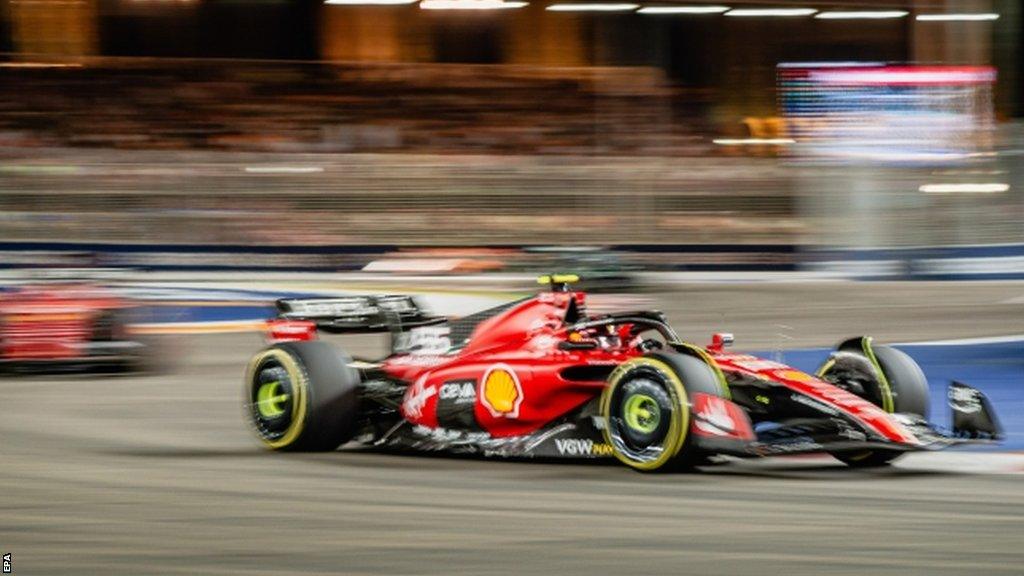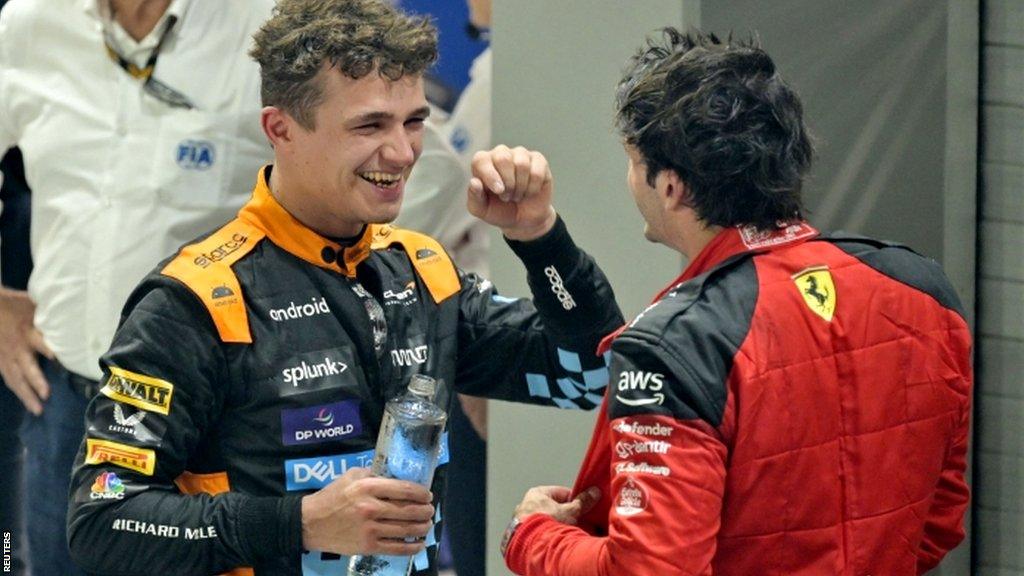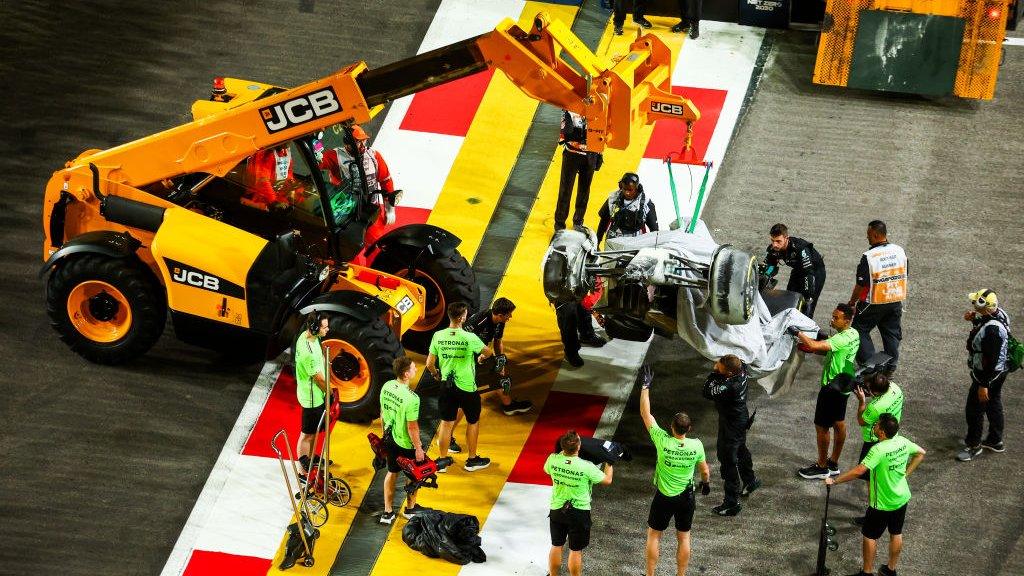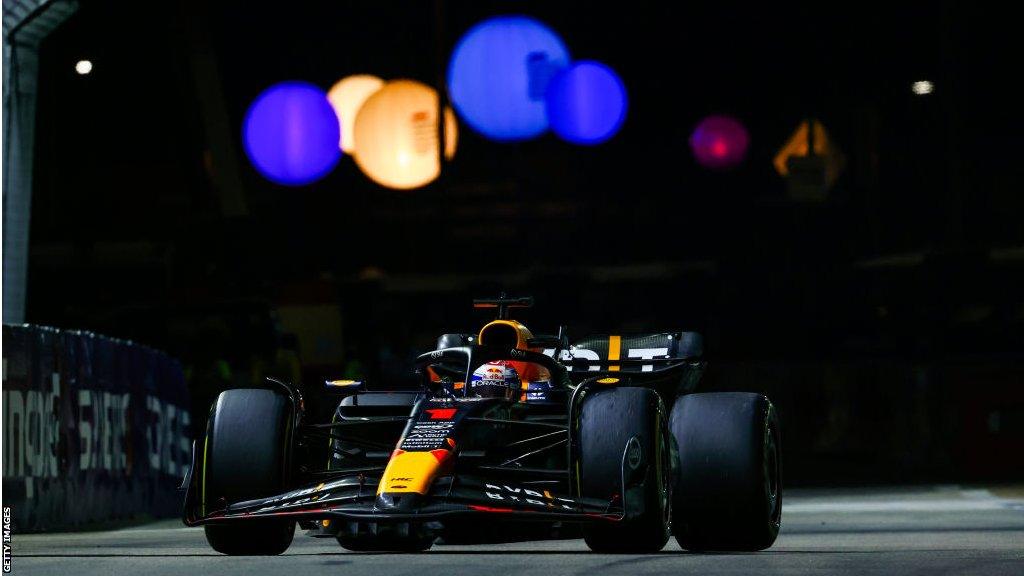Singapore Grand Prix: 'Turning point? No, but Singapore was fun while it lasted'
- Published
- comments

Carlos Sainz converted his fifth career pole position into a second victory to finally break Red Bull's stranglehold on the 2023 season
Red Bull finally faltered at the Singapore Grand Prix, and it was Carlos Sainz and Ferrari who stepped forward and grabbed the win that the opposition has felt for most of this year might never come.
Sainz led from start to finish and did not put a foot wrong, but this was far from an easy win, in a race that demonstrated what has long been clear - what a spectacle Formula 1 would be this year if Red Bull were taken out of the picture.
Sainz crossed the line with McLaren's Lando Norris and Lewis Hamilton's Mercedes right on his tail. On the final lap, George Russell, who not long before had looked like winning after a bold strategy call, crashed out of third place.
It was the race for which F1 and much of its audience - with apologies to any Red Bull fans - had been waiting for a long time.
It was the first time Red Bull had been beaten since the penultimate race of last season in Brazil; the first time Max Verstappen had not won since the Azerbaijan Grand Prix back in April.
No-one was under any illusions that Singapore is about to set a new pattern, but it was certainly fun while it lasted.
Ferrari hold their nerve to 'nail' golden chance
Up front, Ferrari delivered a win that in the past they may well have let slip through their fingers. Through 2022, particularly, but for some years before that too, their strategy team was at times a laughing stock, and a number of victories - in races, but also in championships - have been lost as a result.
But on Sunday it all went as they had intended. Ferrari planned the race meticulously, to the point of employing Charles Leclerc strategically to ease the way for Sainz's win. Then, towards the end, when a late twist set up a grandstand finish, Sainz applied his renowned nous and intelligence to hold on, when he could so easily have lost out.
At Ferrari, the joy at doing what they have fumbled in the past was evident, and Sainz expressed it.
"We've had one opportunity this year to win the race," he said, "which was here in Singapore, and we nailed it. We didn't put a foot wrong all weekend and, yeah, there were a lot of moments out there where we were a bit under pressure and we kept it calm.
"We kept our plan, our strategy. We had to play with tyre degradation, with pit-stop gaps, with DRS. And playing with all that, and managing to keep everything under control, we managed to bring home a win that was never easy, but that definitely feels incredible."
After controlling the pace and managing the field all race, on a track where overtaking is notoriously difficult, Sainz's late tension was provided by a virtual safety car with just under 20 laps to go.
Mercedes had been looking for this opportunity, which gave them a chance to switch to the two-stop strategy they had targeted, and for which they alone had saved an extra set of new medium tyres.
It dropped Russell and Hamilton from second and fourth places to fourth and fifth. But now they had fresh rubber to attack with and they went to work.
There was a 13.5-second gap to Leclerc in third, but Russell closed it in seven laps, as Hamilton also closed on him, and they went past the Ferrari like it wasn't there.
Now Sainz realised he had a problem. And this is where the team planning of early in the race made way for driver improvisation.
Sainz realised he needed to slow down so that Norris was within a second of him, giving the McLaren the use of the DRS overtaking aid. It would increase the pressure Sainz had from Norris, but it would minimise the real threat by making the McLaren harder to pass.

Sainz's victory was as much about tactical nous as it was raw speed, as he and Lando Norris combined to hold off the flying Mercedes in the final laps
"It surprised me quite a lot how quickly the Mercs managed to pass Charles and close the gap on Lando and me," Sainz said. "And I thought: 'OK, it's not going to be easy and these last five, six laps is going to be a fight.
"And at that point, obviously I had to change a bit the strategy. I had to give Lando a bit of a cheeky DRS boost, and that helped us to keep them behind and win the race and get the win for Ferrari that feels great.
"There was in particular one lap that I think Lando defended into Turns 16-17, and then I had to slow down a lot into Turns One, Two and Three to give him DRS again.
"I think that move actually saved my race, saved also Lando's P2, because I feel like there, if not, I would have been also dead meat. If the Mercs would have passed Lando, I think they could have got past me pretty easily.
"This is a sort of strategy that you always keep in the back of your head in tracks like Singapore, where it might come in useful at some point.
"The thing is, obviously, it's easy to have in mind, but it's a lot more difficult to execute it because it does put you under some extra pressure and it comes with its risks.
"And it's all about having that commitment to do it and to put yourself under that extra risk. But I felt like that was my only real chance of winning the race and I wanted to win."
The defensive move Sainz was referring to was on lap 59, with four to go. Russell got a run on Norris out of Turn 14 and pulled alongside. He looked certain to pass, but Norris hung on, with help from pressing his 'overtake' button for a brief power boost.
"Carlos played it smart," said Norris, who admitted he had concentrated on securing second rather than attacking the Ferrari. The DRS boost was "very helpful - we together played it in a smart way to get the Mercs to stay behind us".

Norris and Sainz's late-race tactics helped preserve their positions ahead of the Mercedes and earn the British McLaren driver his third second-placed finish of the season
Sainz 'proud' of Ferrari progress
For Sainz, the result was proof of the progress Ferrari have been making this year under new team principal Frederic Vasseur.
They started this year with a bit of a shock - the car did not meet expectations. It was off the pace, its handling was vicious and it worked its tyres too hard. Upgrades through the season have progressively improved it, and on certain circuits with certain types of corners, it is now decently competitive.
Sainz has found a rich vein of form since F1 resumed after its summer break, and was thrilled to take his first since last year's British Grand Prix - ironically one of the races where Ferrari demonstrated their strategic weaknesses by blowing a win for Leclerc.
But he added: "What I'm more proud of is that we had one chance to win this year, and the team under pressure responded. I also responded and we managed to put together a perfect weekend in the one chance that the Red Bull and the situation gave us.
"This speaks well of the progress that Ferrari is doing in terms of race execution."
Russell heartbroken by error

George Russell's bold switch to medium tyres might easily have delivered a second career win - instead, his charge ended on the final lap, bringing a third retirement of the season
After his attack on Norris on lap 59, Russell was never so close again, and then on the last lap a small error undid all his good work.
First Norris clipped the wall on the entry to Turn 10 - lightly, but just enough to bend his steering - and then right behind Russell did too, but more heavily. It broke the Mercedes' suspension and he crashed.
Afterwards, Russell was close to tears.
"I feel like I left myself and team down," he said. "It's tough."
"We were half a car's length away from winning the race, had I been able to overtake Lando when I had that one opportunity, because Carlos did such a great job of dictating the pace and giving Lando the DRS that we couldn't get a chance of overtaking Lando.
"And then the last lap, I don't know what the hell happened there. Maybe a lapse of concentration, maybe frustration knowing that was our opportunity gone, and a mistake of one or two centimetres has put such a shadow over the whole weekend.
"The team did an amazing job, the car was great, the strategy was bang on, we were brave and bold, it was exciting out there and it is heartbreaking to be standing here with no points."
What happened at Red Bull?
None of this would have happened without an unusually off-form weekend from Red Bull.
After qualifying 11th, Verstappen described his car as "shocking". Norris said that after watching a video of the lap from the Red Bull's onboard camera "I kind of laughed because I've never seen a car that bad before - Max also laughed about it".
Red Bull had come to Singapore expecting it to be their toughest race of the season but no-one - inside the team or outside - expected them to be this bad.
F1 teams are secretive by nature, but Red Bull take that - as so much else - to extremes and were not about to explain what had gone wrong. Chief engineer Paul Monaghan admitted they had "some problems in the car that we know about that we can't fix immediately, the circuit didn't do us any favours, and we made a number of errors in approaching qualifying."

Verstappen now leads team-mate Sergio Perez by 151 points, which means he cannot win the title in Japan next weekend
Team principal Christian Horner said: "Maybe our simulation didn't lead us to the right conclusion. And you have to unravel your way out of that and we ended up in the wrong window, which exposed some of the weaknesses the car has, which has actually been a very useful lesson for next year."
The car started the weekend a long way off where they expected it to be. With the set-up out of whack, the tyres did not work properly, and they found themselves in a vicious circle. Going backwards and forwards on set-up chasing performance, Red Bull ran the car too low in qualifying chasing performance.
In the race, Verstappen was inevitably more competitive. The timing of the safety cars worked against Red Bull, but the world champion climbed up from 15th after his pit stop to right on the tail of Leclerc's Ferrari across the line to take fifth.
"We understood a lot more in the race," Horner said, "and the pace of the car came more back to what we expected. So I think we got a very good steer. In the latter stint, Max's pace was very strong."
Horner said there was no disappointment at the end of their winning run,
"We never expected it," he said. "There were still eight races to go. To have got through 15 races is beyond our wildest imaginations, for Max to win 10 in a row is insanity. We're incredibly proud."
Up and down the pit lane, there was inevitable speculation that a technical directive from governing body the FIA before the race aimed at clamping down on flexible bodywork had impacted Red Bull.
But Horner dismissed that, saying: "It's not changed a single component on our car."
So how was it possible to lose so much pace, he was asked?
"It is such a complicated sport," Horner said. "The competition is so high and to have a car that is competitive across every single venue in every condition on every compound of tyre is a hell of a challenge. We saw it even across the Mercedes periods of domination that sometimes they would come here and struggle."
Mercedes team principal Toto Wolff said: "I have no doubt they will be strong at the more conventional race tracks, but it's a breath of fresh air that we have a different winner and a podium without them.
"And you have to take the small positives in a year of Red Bull dominance."

What's next in the Post Office Horizon scandal? Nick Wallis continues his investigation into the widest miscarriage of justice in UK legal history
The batsman who changed the face of cricket: How wearing a helmet revolutionised the safety of the sport

